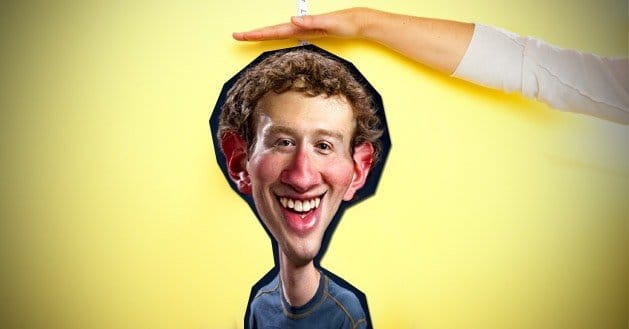 Written by ContentPowered.com
Written by ContentPowered.com
As the leading online social networking service, Facebook has shown considerable annual growth since its founding in 2004. In the summer of 2012, Facebook launched its Initial Public Offering (IPO) which was one of the most anticipated Wall Street events in stock market and Internet history. Unfortunately, this initial excitement became frustration when the stock toppled by close to 50% of the initial price. Luckily, since that debacle, the stock has risen by 50%.
In such a short period of time, this was an incredible amount of volatility. With such an unstable start, this begs the question as to how much growth Facebook has experienced since its inception. With only ten years under their belt, Facebook is still considered a young company in the business world. A good predictor of future growth is always the amount of growth that has occurred in the past. Therefore, by predicting the amount Facebook has grown every year, their future is in the numbers.
Yearly Growth
Although the company was founded in 2004, it was not monetized until 2006. The majority of Facebook’s revenue is derived from advertising. Surprisingly, Facebook boasts a lower clickthrough rate on posted advertisements than the majority large websites. Businessweek.com notes that the banner advertisements located on Facebook only receive one-fifth of the clicks when compared with those in browsers. Clickthrough rates are extremely important in determining growth as the more clicks on advertisements; the higher chance a user will make a purchase.
According to Facebook’s Online Sales Operations Manager, up until 2012, even the most successful advertising campaigns received clickthrough rates as low as 0.04%. In comparison, the advertisement clickthrough rates on other social networks were around 0.1%. Although this is still low when compared to other websites, it is 2.5 times better than Facebook.
The cause of this low clickthrough rate can be ascribed to users enabling their pop-up and ad blockers as well as simply ignoring advertisements. Digital consultants, iStrategy Labs, found in early January of 2014, three million fewer users between the ages of 13 and 17 were on the Social Advertising platform when compared to the 2011 fiscal year.
On the other hand, pages for specific brands and/or products can see clickthroughs as high as 6.49% for Wall postings. Another study found that 40% of users who viewed video advertisements on Facebook watched the entire video. In comparison, the industry average is 25% for in-banner videos.
The Numbers
Beginning in 2006, Facebook posted $52 million in revenue. Since this was the first year of monetization through advertising, they made a significant capital for a startup company. In 2007, the company really began to take-off with a 188% growth rate from 2006 and $150 million in revenue. 2008 brought another 87% growth rate and $280 million in revenue. In 2009, the company reported $775 million in revenues and a 177% growth over the previous year.
In 2010, the revenues jumped significantly past $2 billion and again had triple digit growth with 158%. In 2011, Facebook almost doubled its revenue to $3.7 billion and 86% growth. In 2012, Facebook reported its lowest growth in six years with 37% and $5 billion in revenue. However, that number rebounded in 2013 with $7.8 billion in revenue and a 55% growth.
At the end of January 2014, Facebook reported revenues of just under $2.6 billion in revenue for the first three months that ended on December 31st, 2013. Also, earnings per share (EPS) were 31 cents and Facebook’s total profit was $1.5 billion in 2013. According to a study conducted by eMarketer, Facebook accounted for 5.7% of all worldwide digital ad revenues in 2013. By comparison, Google held 32.4%.
Contributions to Growth
Facebook announced on November 15th, 2010 that it had acquired the fb.com domain name from the American Farm Bureau Federation. The amount that it was purchased for was initially undisclosed. Then, on January 11th, 2010, the American Farm Bureau Federation released that it made $8.5 million in domain sales income. Therefore, the purchase of fb.com was one of the top ten highest domain name sales in the history of the Internet.
In 2010, Facebook launched its fourth office in Hyderabad, India as well as its first brand in Asia. The company had 750 million users globally in 2010 with 23 million in India. Therefore, they moved online advertising and developer support to the Hyderabad location to provide around-the-clock, multi-lingual technical support for social networking advertisers and users.
A year later, the company built a customized data center that utilized 38% less power consumption compared to its other data centers. Also, in early 2011, Facebook moved its headquarters to the old Sun Microsystems campus located in Menlo Park. In 2012, Facebook opened a second data center located in Forest City, North Carolina.
Also in 2012, Founder Mark Zuckerburg made a trip to Moscow in an effort to motivate the use of Facebook by Russian citizens. The Communications Minister released that Zuckerburg should eliminate plans to take away talented Russian programmers and consider opening another data center. Currently Russia has 9 million active users.
One not well-known fact is that users who are located outside of North America sign a contract in their terms and conditions with Facebook’s Irish business subsidiary, Facebook Ireland Limited. By using this international company, Facebook avoids United States taxes for users located in Asia, Australia, Africa, Europe and South America. The deal Facebook has struck with Ireland is that they pay the 2-3$ corporate tax on all international revenue. This is known as the Double Irish arrangement and has saved Facebook a significant amount of money.
Recent Growth
Recently, in February 2014, Facebook purchased WhatsApp for $19 billion. WhatsApp is a popular personal real-time messaging network that allows millions of global users to remain connected with family and friends through messaging. It is essentially a replacement for current text messaging. Social media experts believe that WhatsApp could actually become larger than a simple messaging application. There are currently 450 million monthly users worldwide and more than 320 million daily users. Although the app is free, users are required to pay only $0.99 per year.
Social Impact of Facebook
The social impact of Facebook has been immeasurable. The website has affected the social lives of hundreds of millions of individuals in a variety of ways. With the integration of Facebook onto mobile devices, the company has allowed users to connect in a completely new manner. Many argue that Facebook is beneficial for social lives because it allows friends, family and acquaintances to remain in constant contact. The opposing side believes that Facebook promotes antisocial behavior because two people are not directly in communication with one another via phone call or face-to-face.
Political Impact of Facebook
Facebook played a major role in American politics in the 2008 election. Prior to the New Hampshire primary, Facebook collaborated with ABC and Saint Anselm College to give users the opportunity to provide live feedback with regards to the Republican and Democratic debates. During the debate, Facebook users partook in online debate groups, voting registration and messaged their questions. Additionally, there have been many petitions posted on Facebook on a variety of topics over the past several years. Some have had a successful influence while others have not.


Just wait until Facebook finally branches out into China 😉
thank you for pulling these facts!